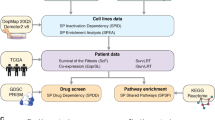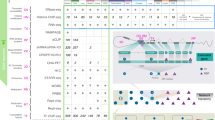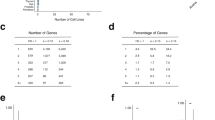Abstract
RNA interference (RNAi) is a major, powerful platform for gene perturbations, but is restricted by off-target mechanisms. Communication between RNAs, small RNAs, and RNA-binding proteins (RBPs) is a pervasive feature of cellular RNA networks. We present a crosstalk scenario, designated as ‘crosstalk with endogenous RBPs’ (ceRBP), in which small interfering RNAs or microRNAs with seed sequences that overlap RBP motifs have extended biological effects by perturbing endogenous RBP activity. Systematic analysis of small interfering RNA (siRNA) off-target data and genome-wide RNAi cancer lethality screens using 501 human cancer cell lines, a cancer dependency map, identified that seed-to-RBP crosstalk is widespread, contributes to off-target activity, and affects RNAi performance. Specifically, deconvolution of the interactions between gene knockdown and seed-mediated silencing effects in the cancer dependency map showed widespread contributions of seed-to-RBP crosstalk to growth-phenotype modulation. These findings suggest a novel aspect of microRNA biology and offer a basis for improvement of RNAi agents and RNAi-based functional genomics.
This is a preview of subscription content, access via your institution
Access options
Access Nature and 54 other Nature Portfolio journals
Get Nature+, our best-value online-access subscription
$29.99 / 30 days
cancel any time
Subscribe to this journal
Receive 12 print issues and online access
$209.00 per year
only $17.42 per issue
Buy this article
- Purchase on Springer Link
- Instant access to full article PDF
Prices may be subject to local taxes which are calculated during checkout




Similar content being viewed by others
Change history
20 July 2018
In the version of this article originally published, in the abstract, a single open quotation mark was missing due to a publisher error. The sentence beginning “We present a crosstalk scenario, designated as crosstalk with endogenous RBPs’ (ceRBP), in which…” should have read, “We present a crosstalk scenario, designated as ‘crosstalk with endogenous RBPs’ (ceRBP), in which….” This error has now been corrected in the HTML and PDF versions of the paper.
References
König, R. et al. A probability-based approach for the analysis of large-scale RNAi screens. Nat. Methods 4, 847–849 (2007).
Shao, D. D. et al. ATARiS: computational quantification of gene suppression phenotypes from multisample RNAi screens. Genome Res. 23, 665–678 (2013).
Tsherniak, A. et al. Defining a cancer dependency map. Cell 170, 564–576.e16 (2017).
McDonald, E. R. III et al. Project DRIVE: a compendium of cancer dependencies and synthetic lethal relationships uncovered by large-scale, deep RNAi screening. Cell 170, 577–592.e10 (2017).
Bosson, A. D., Zamudio, J. R. & Sharp, P. A. Endogenous miRNA and target concentrations determine susceptibility to potential ceRNA competition. Mol. Cell 56, 347–359 (2014).
van Kouwenhove, M., Kedde, M. & Agami, R. MicroRNA regulation by RNA-binding proteins and its implications for cancer. Nat. Rev. Cancer 11, 644–656 (2011).
Berezikov, E. Evolution of microRNA diversity and regulation in animals. Nat. Rev. Genet. 12, 846–860 (2011).
Boudreau, R. L. et al. siSPOTR: a tool for designing highly specific and potent siRNAs for human and mouse. Nucleic Acids Res. 41, e9 (2013).
Garcia, D. M. et al. Weak seed-pairing stability and high target-site abundance decrease the proficiency of lsy-6 and other microRNAs. Nat. Struct. Mol. Biol. 18, 1139–1146 (2011).
Ray, D. et al. A compendium of RNA-binding motifs for decoding gene regulation. Nature 499, 172–177 (2013).
Jønson, L. et al. IMP3 RNP safe houses prevent miRNA-directed HMGA2 mRNA decay in cancer and development. Cell Rep. 7, 539–551 (2014).
Degrauwe, N. et al. The RNA binding protein IMP2 preserves glioblastoma stem cells by preventing let-7 target gene silencing. Cell Rep. 15, 1634–1647 (2016).
Goodarzi, H. et al. Endogenous tRNA-derived fragments suppress breast cancer progression via YBX1 displacement. Cell 161, 790–802 (2015).
Lu, Y. C. et al. ELAVL1 modulates transcriptome-wide miRNA binding in murine macrophages. Cell Rep. 9, 2330–2343 (2014).
Moretti, F., Kaiser, C., Zdanowicz-Specht, A. & Hentze, M. W. PABP and the poly(A) tail augment microRNA repression by facilitated miRISC binding. Nat. Struct. Mol. Biol. 19, 603–608 (2012).
Sebestyén, E. et al. Large-scale analysis of genome and transcriptome alterations in multiple tumors unveils novel cancer-relevant splicing networks. Genome Res. 26, 732–744 (2016).
Hafner, M. et al. Transcriptome-wide identification of RNA-binding protein and microRNA target sites by PAR-CLIP. Cell 141, 129–141 (2010).
JnBaptiste, C. K. et al. Dicer loss and recovery induce an oncogenic switch driven by transcriptional activation of the oncofetal Imp1-3 family. Genes Dev. 31, 674–687 (2017).
Mukherji, S. et al. MicroRNAs can generate thresholds in target gene expression. Nat. Genet. 43, 854–859 (2011).
Agarwal, V., Bell, G. W., Nam, J. W. & Bartel, D. P. Predicting effective microRNA target sites in mammalian mRNAs. eLife 4, e05005 (2015).
Lee, C. G., McCarthy, S., Gruidl, M., Timme, C. & Yeatman, T. J. MicroRNA-147 induces a mesenchymal-to-epithelial transition (MET) and reverses EGFR inhibitor resistance. PLoS One 9, e84597 (2014).
Acknowledgements
We are grateful to C.K. JnBaptiste, S. Garg, and the members of Sharp laboratories for discussions and assistance, and to R.L. Boudreau and B.L. Davidson for siSPOTR analysis. We thank the Robert A. Swanson (1969) Biotechnology Center at the Koch Institute for Integrative Cancer Research at Massachusetts Institute of Technology for technical support, specifically G. Paradis, M. Jennings, and M. Saturno-Condon of the Flow Cytometry Core Facility. H.I.S. is supported by the Uehara Memorial Foundation Research Fellowship and the Osamu Hayaishi Memorial Scholarship for Study Abroad. This work was supported by United States Public Health Service Grants R01-GM034277 and R01-CA133404 to P.A.S. from the National Institutes of Health, and by the Koch Institute Support (core) Grant P30-CA14051 from the National Cancer Institute.
Author information
Authors and Affiliations
Contributions
H.I.S. conceived and designed the research, performed computational and experimental analyses, and wrote the manuscript with contributions from all authors. R.M.S. provided data resources. G.G. and T.K. carried out miRNA mutation project. P.A.S. supervised the project and writing of the manuscript.
Corresponding author
Ethics declarations
Competing interests
The authors declare no competing interests.
Additional information
Publisher’s note: Springer Nature remains neutral with regard to jurisdictional claims in published maps and institutional affiliations.
Integrated supplementary information
Supplementary Figure 1 Effects of overlap between siRNA seeds and known RBP motifs on expression changes of downregulated off-target genes.
Expression changes of downregulated off-target genes (transcripts with 3´ UTRs containing 7- and 8-mer seed-binding sites and ≤ -0.3 log2 fold change) are shown for two groups. Although not significant, downregulated off-target genes for RBP motif-overlapping siRNAs tended to show relatively larger expression changes relative to those for non-overlapping siRNAs. Statistical significance was assessed using two-sided Wilcoxon signed rank test. n.s.: not significant.
Supplementary Figure 2 Results of DEMETER–ceRBP analysis.
For several RBPs, distributions of Z-scores of Pearson correlation coefficients for pairs of indicated RBPs and all seeds or motif-overlapping seeds (red: competitive, blue: cooperative) are shown. P values were calculated by one-sided Kolmogorov–Smirnov (K-S) test for either direction depending on the median changes.
Supplementary Figure 3 IGF2BPs target analysis.
The left plot shows expression changes of IGF2BP1/2/3-bound transcripts defined by PAR-CLIP upon triple knockdown of IGF2BP1/2/3, based on the PAR-CLIP and microarray datasets from Hafner et al. (2010), indicating destabilization of IGF2BP1/2/3-bound transcripts upon their depletion. The middle panel shows expression changes of IGF2BP1/2/3 PAR-CLIP targets upon triple knockout of Igf2bp1/2/3 in mouse mesenchymal stem cells, based on the RNAseq datasets from JnBaptiste et al. (2017). P values were calculated by two-sided Wilcoxon signed rank test with Bonferroni correction. We focused on the representative target HMGA2 and selected shRNAs with IGF2BP2 motif-overlapping seeds and RBP motif non-overlapping seeds for subsequent functional analyses as shown in the right panel.
Supplementary Figure 4 Flow cytometry gating strategies.
A representative example of gating strategy for MSC.
Supplementary Figure 5 Distribution of DEMETER solutions for shRNAs with RBP motif overlapping seeds.
Distribution of DEMETER gene solution and seed solutions for shRNAs with seeds overlapping the motifs of indicated RBPs are shown (red: competitive, blue: cooperative). For several competitive RBPs including IGF2BP2 (Fig. 4a, middle), RBM28, ESRP2, and RBFOX2, shRNAs with seeds overlapping their binding motifs seldom have high gene effects and low seed effects, i.e. features of good shRNAs (the top-left region). This trend is not observed for PABPC1 (Fig. 4a, right) and RBM47.
Supplementary Figure 6 Effects of ceRBP crosstalk on DEMETER gene solutions.
All shRNAs (~100,000) are grouped into three groups according to values of DEMETER seed solutions shown in Fig. 4a (q1: < 0.2, q2: ≥ 0.2 and < 0.6, and q3: ≥ 0.6), and values of DEMETER gene solution are compared. shRNAs with competitive seeds have significantly lower gene effects in a q1 group. P values (versus no overlap) were calculated by two-sided Wilcoxon signed rank test with Bonferroni correction. n.s.: not significant.
Supplementary Figure 7 Effects of ceRBP crosstalk on the performance of shRNAs for cancer essential genes.
shRNAs for 448 cancer genes differentially required in subsets of 501 cancer cell lines are analyzed, and distribution of DEMETER gene solution and seed solutions for shRNAs without RBP overlapping seeds (left) or with competitive (middle, Z-score > 2) or cooperative (right, Z-score < -2) seeds are shown.
Supplementary Figure 8 Effects of miRNA-type seeds on DEMETER gene solutions.
All shRNAs are grouped as in Supplementary Fig. 6, and values of DEMETER gene solution are compared. shRNAs with seeds overlapping broadly conserved miRNAs show an approximately twofold decrease in gene effects in a q1 group. P values (versus no overlap) were calculated by two-sided Wilcoxon signed rank test with Bonferroni correction. n.s.: not significant.
Supplementary Figure 9 Overlap between endogenous miRNA seeds and RBP binding motifs.
A percentage of seeds overlapping the RBP binding motifs is shown. Numbers in parentheses indicate the total number of each small RNA group.
Supplementary information
Supplementary Figures
Supplementary Figures 1–9
Supplementary Table 1–3
Supplementary Table 3
Rights and permissions
About this article
Cite this article
Suzuki, H.I., Spengler, R.M., Grigelioniene, G. et al. Deconvolution of seed and RNA-binding protein crosstalk in RNAi-based functional genomics. Nat Genet 50, 657–661 (2018). https://doi.org/10.1038/s41588-018-0104-1
Received:
Accepted:
Published:
Issue Date:
DOI: https://doi.org/10.1038/s41588-018-0104-1
This article is cited by
-
Systematic characterization of seed overlap microRNA cotargeting associated with lupus pathogenesis
BMC Biology (2022)
-
The regulatory impact of RNA-binding proteins on microRNA targeting
Nature Communications (2021)
-
Gain-of-function mutation of microRNA-140 in human skeletal dysplasia
Nature Medicine (2019)



